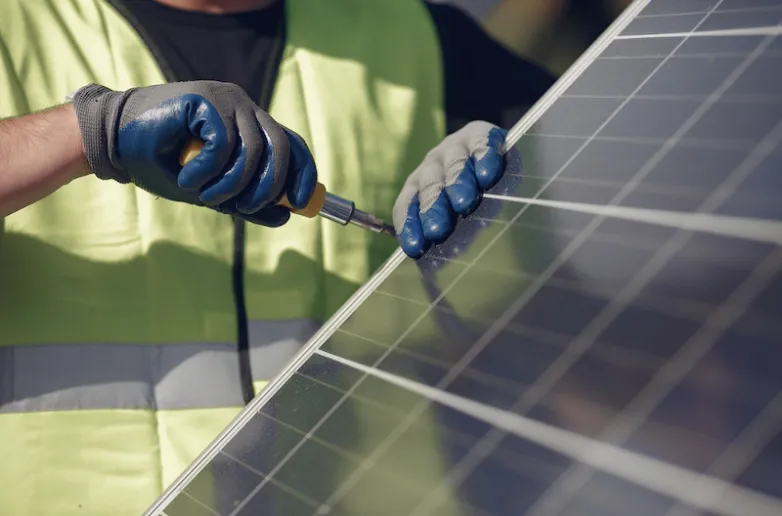Solar Aeration System: Aerate Your Pond Without Electricity

A healthy pond is a tranquil addition to your landscape and a vital ecosystem for aquatic life. The key to maintaining this vibrancy lies in the oxygen levels, which you can manage through aeration. Traditional electric aerators have long been the standard solution for this task. However, pond owners are moving to more sustainable options.
Enter the solar aeration system—a revolutionary approach that allows you to aerate your pond without relying on traditional electricity sources. Hence, this article explores how solar aeration systems work and why they might be the perfect fit.
Understanding How Solar Aeration Systems Work
Solar aeration is an innovative technology that utilizes solar energy to oxygenate pond water, enhancing the overall health and clarity of the water body.
The primary component is the solar panel, which captures sunlight and converts it into electrical energy. This panel connects to a charge controller that regulates the voltage and current to prevent battery overcharge and to optimize the power output. The electricity generated by the solar panel is either used immediately or stored in batteries for later use, especially during cloudy days or nighttime when direct sunlight is unavailable.
Another component is the air pump or compressor, which relies on the electricity from solar panels or batteries. The air pump pushes air through tubing to diffusers or air stones at the bottom of the pond. These diffusers release the air as tiny bubbles, which rise to the surface.
As these bubbles ascend slowly, they create upward currents to circulate the water, enhancing the oxygen transfer between the air and the water. This process not only injects oxygen into the water but also helps to break down harmful gasses like ammonia and methane, which can accumulate in ponds and harm aquatic life.
Benefits of Using a Solar Aeration System
Here are the key advantages of having a solar pond aeration system:
Energy Efficiency and Cost Savings
One of the most compelling benefits of solar aeration systems is their ability to operate without relying on grid electricity, which can significantly reduce energy costs. After the initial investment in the equipment, the ongoing operational costs are minimal since sunlight is free.
Over time, these savings can offset the upfront cost, making solar aeration economically advantageous, especially in regions with high electricity rates or where the system can run predominantly on solar power without needing much battery backup.
Environmental Benefits
By using solar power, these systems reduce the carbon footprint associated with traditional electric aerators that often rely on fossil fuels indirectly through grid electricity. Additionally, solar aeration contributes to a healthier pond ecosystem that can support a wider variety of plant and animal life, promoting biodiversity.
Low Maintenance
Compared to traditional aerators, solar aeration systems typically require less maintenance. The absence of electrical wiring and the simple design of solar components reduce the potential for mechanical failures. Solar panels generally need only periodic cleaning to maintain their efficiency, and modern batteries designed for solar applications have long lifespans and require minimal upkeep.
Increased Property Value
Installing a solar aeration system can also increase property value, particularly for properties with aesthetic or functional water bodies. Prospective buyers often view solar technology as a premium upgrade due to its sustainability and energy-saving benefits, making it an attractive feature during real estate transactions.
Scalability and Flexibility
Solar aeration systems are scalable and can be customized to fit the specific needs of any pond size or type, from small decorative ponds to large agricultural or recreational lakes. You can add panels and batteries to increase capacity or place more air stones to enhance oxygen distribution. Such flexibility allows pond owners to tailor the system to their precise requirements.
Types of Solar Aeration Systems
Solar aeration systems come in various configurations, each designed to meet different needs and environmental conditions. The two main types of systems are direct drive systems and battery backup systems:
Direct Drive Systems
These systems rely on solar panels; hence, they do not require batteries for storing energy. The system starts to aerate the pond when the sun shines on the solar panels. This type of system is particularly suited for locations with consistent sunlight throughout the day.
Battery Backup Systems
Battery backup systems include batteries that store solar energy, allowing the aeration system to function during cloudy days and after sunset. This system provides a continuous oxygen supply to the pond, regardless of the solar conditions at any given moment.
Both types of solar aeration systems offer distinct benefits and can be chosen based on the specific requirements of the pond and the local climate conditions. Direct drive systems are simpler and might suit small ponds in sunny areas, whereas battery backup systems offer more robust and reliable aeration for larger or more ecologically sensitive ponds.
Conclusion
Embracing solar aeration systems represents a forward-thinking approach to pond management, blending technology with environmental stewardship. These systems reduce reliance on non-renewable energy sources and provide cost savings.
Additionally, solar aeration systems offer the convenience of low maintenance and the flexibility to function in remote or off-grid locations. However, potential users should consider their local climate and the system's suitability to ensure consistent performance and choose the most suitable system.
Also read
- 5 Critical Metal Forming Processes in Solar Panel Manufacturing
- Maximizing Efficiency with Low-Maintenance Solar Panel Systems
- Cyber Hygiene for Solar Companies: Protecting Your Data from Email Threats
- 5 Hidden Issues That Keep Your Power Bills High With Solar
- Invitation to Solar PV & Energy Storage World Expo 2026

